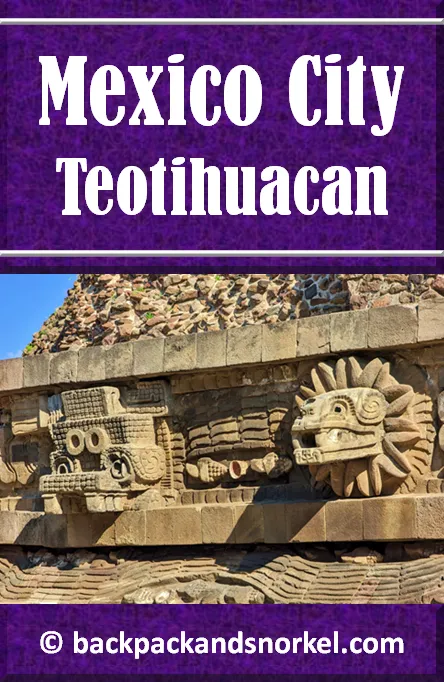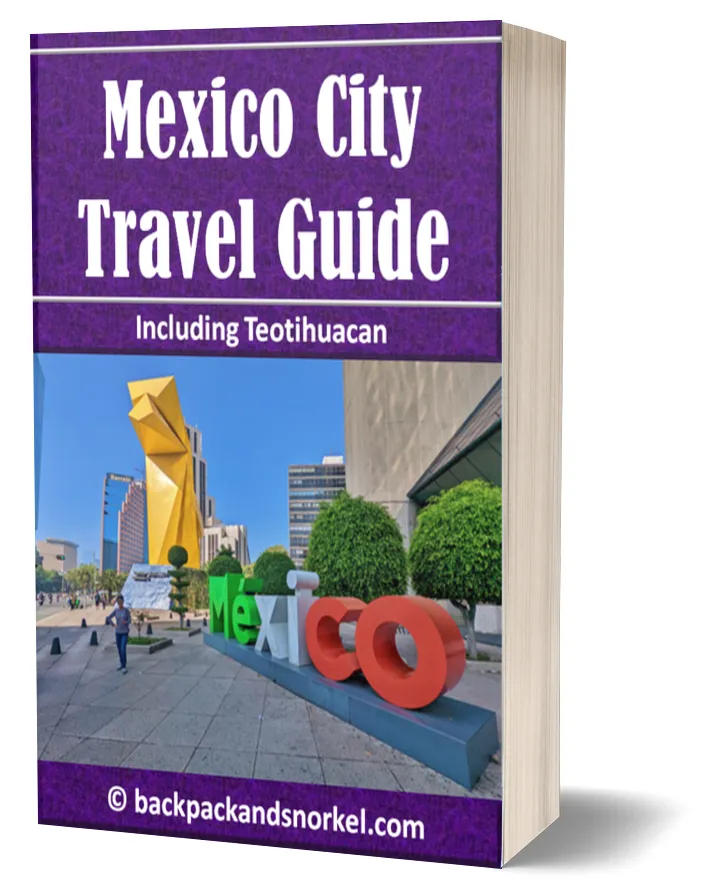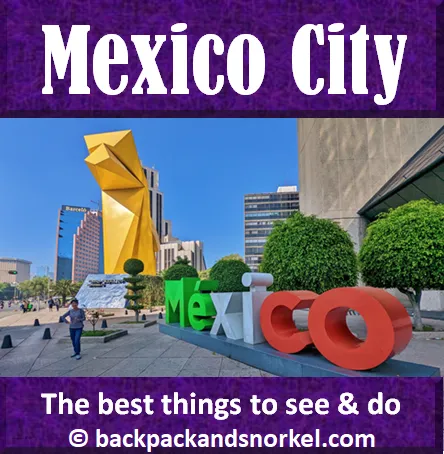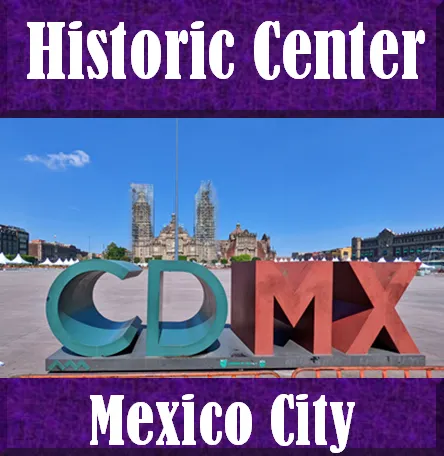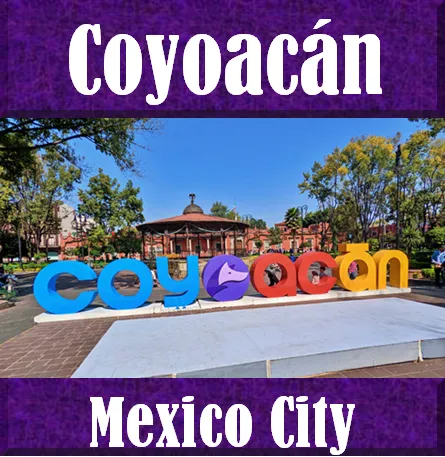Self-guided walking tour of Teotihuacan near Mexico City - Mexico City Purple Travel Guide
Teotihuacan with its pyramids was one of the most important ancient Mesoamerican cities and its ruins are close Mexico City, so you can visit it in one day. We provide you a detailed itinerary with the best things to see and we show lots of photos so you know what you can expect.
Teotihuacan is an ancient Mesoamerican city 25 miles (40 km) northeast of Mexico City. Many of the most architecturally significant Mesoamerican pyramids were built here, like the Pyramid of the Sun which is the third-largest pyramid in the world.
It is estimated at the population of Teotihuacan peaked at around 450 AD with potentially up to 250,000 people, which would make Teotihuacan at least the sixth-largest city in the world at that time.
If you have visited the Museo Nacional de Antropología, then you have seen lots of amazing artefacts that were recovered at Teotihuacan.
There are several tour operators that offer Teotihuacan tours. Most tours also stop at the Basilica Lady of Guadalupe. Be advised that many tours, especially the inexpensive tours, only give you 1-2h at Teotihuacan, which we don’t think is enough time to enjoy the grandeur of this place. More than likely, such tours bring you to various shopping places where the tour guides collect commission from the sellers for everything that you buy.
If you want to spend a wonderful day exploring Teotihuacan, then you can either join a personalized tour with a competent tour guide, or take an uber, or go to Teotihuacan by yourself using the metro and a public long-distance bus.
Honestly, getting to Teotihuacan by metro and bus is real easy and inexpensive, even if you don’t speak Spanish, and that’s why we explain how to do this in the next chapter.
How to pronounce Teotihuacan?
Teotihuacan is pronounced: teo-thu-acahn
Here at Backpack and Snorkel Travel Guides, we typically promote self-guided walking tours.
But we realize that not everybody likes to walk by themselves in a foreign city. So, just in case that you rather go with ab guide: NO PROBLEM! Please see the free GuruWalk and paid Viator tours below.
free GuruWalk tours
paid Viator tours
How to get to Teotihuacan by metro and bus
Zona Arqueológica de Teotihuacán, or for short Teotihuacan, is open daily from 9am to 5pm.
The first thing you do is take a metro to the Autobuses del Norte metro station on the yellow line (line 5). When you exit the metro station, you will see the large crescent shaped façade of the Autobuses del Norte bus terminal right across the street.
Enter the building and go to the far-left side towards Gate 8 (Sala 8).
Two counters before the gate, you will see a ticket counter with a large Autobuses Teotihuacan sign over it. This is where you will buy your bus tickets.
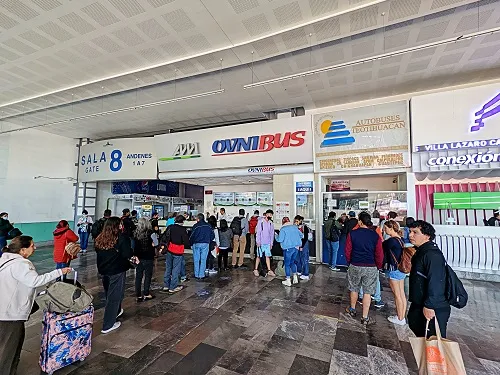
When we were there, the lady at the counter spoke English and accepted credit cards, so buying the tickets was easy.
At the time of writing, a single ride was 52 Pesos, so a round trip for 2 people was 208 Pesos.
When you have your tickets, you go to Gate 8 and wait until boarding for your bus is announced on the monitor.
There are restrooms at the gate that you can use for 6 Pesos.
Once your bus is announced (buses depart every 30 min or so starting at 6am), you board the bus, and the bus ride takes about 1h.
For the best views and photo opps, my recommendation is to sit on the driver’s side of the bus. This way you will see, and be able to photograph, most of the beautiful murals that the bus passes.


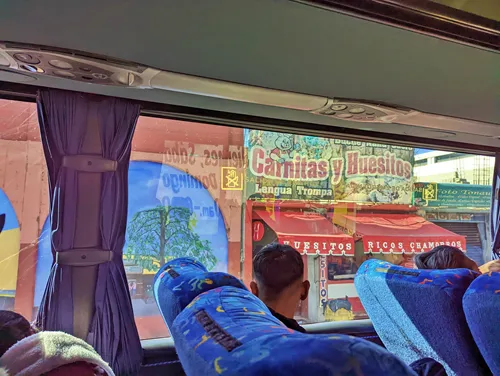
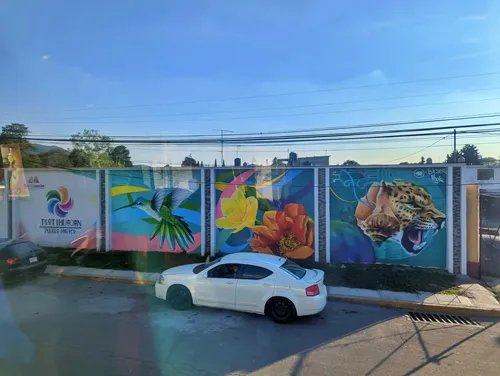
Be advised that Gate 2 at Zona Arqueológica de Teotihuacán, where you should exit, is not the final stop. But don’t worry, most of the people in the bus will exit at Gate 2.
Should you miss this exit, then you can exit at Gate 3, which is the next stop unless the bus driver agreed to let someone out in-between the two gates.
After exiting the bus, follow the street in the direction the bus is driving for about 100 ft until you come to the entrance gate (Gate 2) from where you can already see the majestic Pyramid of the Sun and where you can buy your admission tickets.
At the time of writing, admission was 80 Pesos per adult, payable in cash.

A = Bus stop for Gate 2 |
I = Gate 3 |
B = Gate 2 |
J = Bus stop for Gate 3 |
Zona Arqueológica de Teotihuacán closes at 5pm and the last bus departs at around 6pm. Plan to exit at Gate 3 (near Pyramid of the Moon) and cross the parking lot until you get to the street. There is a brick covered pyramidal mount with Museo De Murales Teotihuacan, Beatriz de la Fuente written on it. This is the bus stop. Wait there until the next bus arrives that will take you to Gate 2 and then back to Autobuses del Norte.
Since buses depart frequently, you should not need to wait for more than 20-30 min.
When you stand at the bus stop and look towards Zona Arqueológica de Teotihuacán, the bus will come from the left.
History of Teotihuacan
- The site where Teotihuacan stands was inhabited since 600BC by maybe 6,000 people who lived in scattered small villages. It is unknown who these people were.
- Period I (200BC – 1BC): local farmers start to settle around the springs in the area and Teotihuacan becomes a more and more urban area.
- Period II (1AD – 350AD): explosive growth makes Teotihuacan the largest metropolis in Mesoamerica, due to volcanic eruptions destroying the farmland of rivaling city of Cuicuilco and economic pull of the big city. Reorganization of buildings to multi-family residential compounds to accommodate 60,000 – 80,000 people and construction of the Temple of the Feathered Serpent and the Pyramids of the Sun and Moon.
Between 250AD and 350AD, shift of political power away from the monarchical Temple of the Feathered Serpent to the more decentralized and bureaucratic organization at the Avenue of the Dead Complex. - Period III (350AD – 650AD): Classical Period of Teotihuacan. The city reaches its peak around 450AD with a population of up to 250,000 people. The city occupies an area of 11.5 square miles (30 square kilometers).
Massive reconstruction takes place. The Temple of the Feathered Serpent was covered with a plaza with rich sculptural decoration. - 378AD: Tikal, in today’s Guatemala (see our Tikal Purple Travel Guide), was conquered by the army of the Feathered-Serpent people, which were outcasts from Teotihuacan.
- Period IV (650AD – 750AD): The end of Teotihuacan. The reasons for the downfall are unknown. The housing compounds of the elite, located around the Avenue of the Dead, have many burn marks. Civil unrest could be responsible for the downfall - no indication of a conquering foreign army was found. Lengthy droughts and possibly a volcano eruption in the 6th century may have hastened or initiated the downfall. It is likely that nearby cities will have been eager to fill the power void and thus accelerated Teotihuacan’s decline.
Teotihuacan remained home for a small population in the coming years. - 1200sAD: The area was slowly repopulated and eventually conquered by the Aztecs. When the Aztecs discovered the overgrown ruins of Teotihuacan, they believed that they had found the birthplace of the sun or the birthplace of the gods. Archeologists are still debating this, but chances are that birthplace of the sun is correct as the site became a place of pilgrimage and was called Tollan, the mystical place where the sun was created.
In Aztec, birthplace of the gods is Teōtīhuacān while birthplace of the sun is Teohuacan. If birthplace of the sun is correct, then we are pronouncing the name of this site all wrong.
Other interesting facts:
- Unlike other cities of that time, Teotihuacan does not appear to have had a king or other authoritarian ruler. It is believed that Teotihuacan was led by some form of a collective governance.
- Teotihuacan has had widespread political and cultural influence on other cultures. In Mayan cities, building styles associated with Teotihuacan were adopted and motives and inscriptions from Teotihuacan were found.
- Now mostly weathered away, the pyramids and other main structures in Teotihuacan were painted in impressive shades of dark red. Very little is still visible today.
Exploring Teotihuacan
What you must bring to Teotihuacan
There is no shade in Teotihuacan, except in the museums. So, make sure to bring lots of sun lotion and a hat. Water can be purchased on site, but it is expensive. So, bring your own water and some snacks.
Climbing most pyramids in Teotihuacan is forbidden
While allowed in the past, it is now forbidden to climb on the pyramids or any other structure. The only exception is a structure in the Temple of the Feathered Serpent. If you climb up, be advised that the steps are tall and steep, and your feet will fit on the steps only sidewards. Losing your balance can be fatal!
Layout of Teotihuacan
Teotihuacan and its pyramids are not oriented in North-South direction, they are skewed by approx. 16 degrees.
The Avenue of the Dead (Calzada de los Muertos) is the main axis that connects the three main visitor sites in Teotihuacan:
- Pyramid of the Sun
- Pyramid of the Moon
- Temple of the Feathered Serpent

Pyramid of the Sun in Teotihuacan
The Pyramid of the Sun (Pirámide del Sol) is the largest building in Teotihuacan and, as it is closest to Gate 2, it should be your first stop on your Self-Guided Walking Tour of Teotihuacan.
The pyramid was named Pyramid of the Sun by the Aztecs, its original name is unknown.
It was built at around 200AD and it is 234 ft (71m) tall, and, at its base, the dimensions are 2,608 ft (795 m) x 733 ft (223 m). The slope is 32.5 degrees.
This makes the Pyramid of the Sun the third largest pyramid, but it is still significantly smaller than the Great Pyramid of Giza, which is 481 ft (147 m) tall and 756 ft (230 m) x 756 ft (230 m) at its base and has a slope of 51.5 degrees.
The pyramid was originally covered with plaster that was painted with brightly colored murals and there was a temple on top.
The location and orientation of the pyramid were chosen as from here, the prominent Cerro Gordo hill can be seen to the north and perpendicular to this direction, the sun rises and sets on specific dates.
The rest of Teotihuacan is aligned with the orientation of the Pyramid of the Sun.
There is a cave under the pyramid which appears man-made. Because it was looted, its function is unknown. Some believe that it may have been a royal tomb.
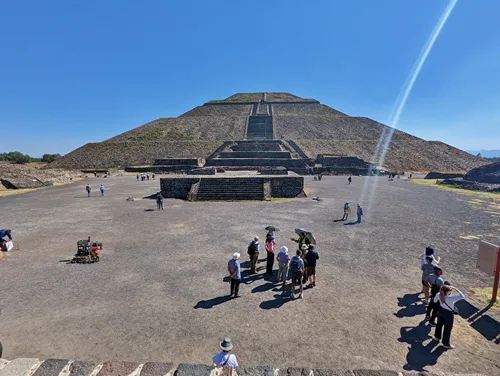

After you are done with the Pyramid of the Sun, you can either proceed to the other monuments in Teotihuacan, of you can visit:
Calzada de los Muertos in Teotihuacan
The Avenue of the Dead (Calzada de los Muertos in Teotihuacan) is a 1 ¼ mile (2 km) long and 148 ft (45 m) wide main thoroughfare of Teotihuacan which connects all three important monuments, the Pyramid of the Sun, the Pyramid of the Moon, and the Temple of the Feathered Serpent.
Residential buildings in Teotihuacan appear to have been segregated into compounds for the high elites, compounds for intermediate elites, and multifamily compounds for the laboring class. Dwellings near the Central district and along the Avenue of the Dead appear to have been occupied by higher class.
The Avenue of the Dead from the Pyramid of the Sun all the way to the Temple of the Feathered Serpent is segmented into different plazas and that means you will need to climb and descend walls with multiple steps to move between the plazas.
Most of the structures to the sides are off-limits but there are some side plazas that you can explore. So, keep your eyes open.



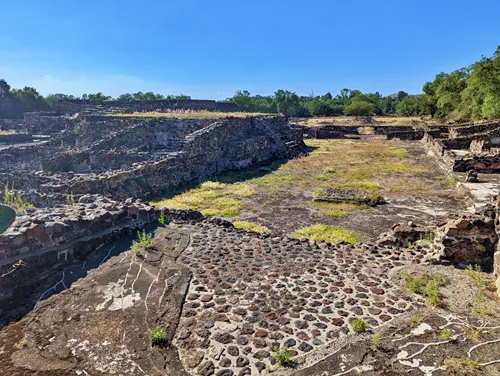
When you walk towards the Pyramid of the Moon, close to the plaza where the Pyramid of the Moon stands, you will see a sign on the right directing to what is left of a Puma Mural.
Just imagine, the pyramids and part of the city painted in these bright colors.



Temple of the Feathered Serpent
The Temple of the Feathered Serpent (Templo de Quetzalcóatl) lies to the very south of the accessible part of Teotihuacan. It contains the smallest of the 3 main pyramids.
The structure was built between 150-200AD, and it seems that during the same time more than two hundred people were buried beneath the structure. It is believed that they may have possibly been sacrificial victims.
The temple has some of the earliest representations of the feathered serpent, which is typically identified with the Aztec god Quetzalcoatl that was popular about 1,000 years later.
The Temple of the Feathered Serpent is enclosed in the much larger Ciudadela (citadel), which surrounds the temple with high walls has a large courtyard on the inside.
The Adosada platform in front of the temple which obscures the temple was built in the 400’sAD and it is the only pyramid in Teotihuacan that you can climb up. If you do, be careful, a fall (especially during the descent) can be deadly!
From the Adosada platform, you have wonderful views on the Temple of the Feathered Serpent, which is a six-level step pyramid that was built in the talud-tablero style, and its still intact feathered serpent heads. The serpent heads alternate with those of another snake-like creature: Tlaloc, the supreme god of rain, earthly fertility and of water.
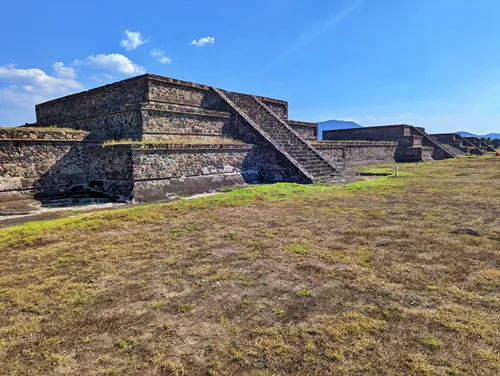
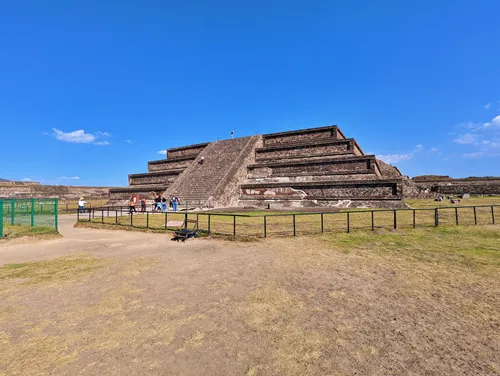
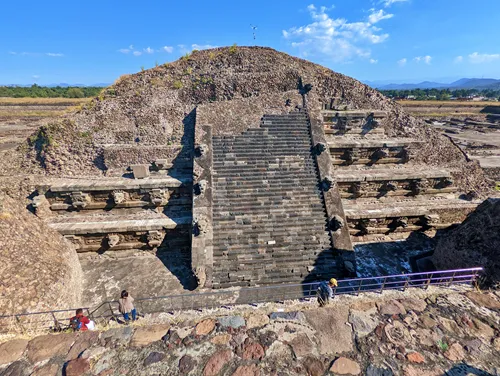

Pyramid of the Moon in Teotihuacan
Your last stop on this self-guided walking tour of Teotihuacan is the Pyramid of the Moon (Pirámide de la Luna).
It is the second largest pyramid in Teotihuacan, and it was built between 100-450AD.
The pyramid is 141 ft (43 m) tall and at its base it measures 482 ft (147 m) x 427 ft (130 m).
The Pyramid of the Moon lies at the northern end of the Avenue of the Dead and the Plaza of the Moon, which was a ritual and sacred site.
The pyramid mimics the contours of the Cerro Gordo mountain behind it. When you walk towards the Pyramid of the Moon on the Avenue of the Dead, at one point near the entrance to the Plaza of the Moon will the pyramid completely obscure Cerro Gordo.
The pyramid was used mainly for human and animal sacrifices and as a burial ground for the victims. A platform on top of the pyramid was used for ceremonies in honor of the Great Goddess of Teotihuacan, who was the goddess of water, fertility, the earth, and creation itself.
The pyramid was built in at least 7 stages. So far, two tombs have been found under the pyramid.
The first tomb contained four human skeletons, animal bones, jewelry, obsidian blades, and a wide variety of other offerings. It is speculated that the tomb may have been dedicated to the fifth phase of construction.
The second tomb was dedicated to The Great Goddess and dated to the fourth stage of construction. It contained one human male sacrificial victim, skeletons of a wolf, jaguar, puma, serpent, bird, and over 400 other offerings including large greenstone and obsidian figurines, ceremonial knives, and spear points.
In the Plaza of the Moon, there is a central altar which was closed at the time of writing due to active research at this site.
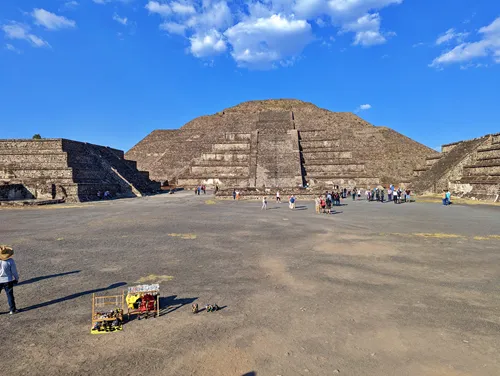


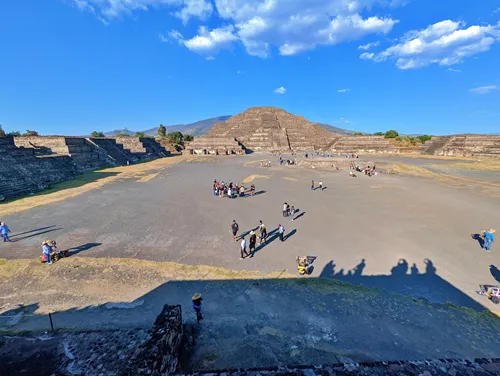
After enjoying the pyramid and plaza, you can exit the Zona Arqueológica de Teotihuacan through Gate 3 and take the bus back to Mexico City.
Museo de la Cultura Teotihuacana in Teotihuacan
The Museo de la Cultura Teotihuacana can easily be reached via the walkway from the south-eastern corner of the Pyramid of the Sun. Follow the signs to the museum and botanical garden and do not exit the Zona Arqueológica de Teotihuacan.
Before you get to the museum you pass an administrative office, gift shop, vending machine and a restrooms. The museum is not visible from there. Just continue on the path and down the stairs and then you will see it.
The museum is not as complete and marvelous as the Museo Nacional de Antropología, but it has many interesting artefacts that were found at Teotihuacan.

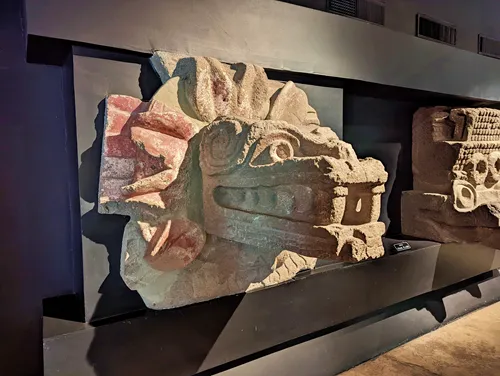


La Gruta restaurant in Teotihuacan
Have you ever wanted to dine in a cave? Look no further. La Gruta may be the restaurant you have been looking for.
The La Gruta restaurant is located outside the Zona Arqueológica de Teotihuacan, and you may need to present your ticket to get back in – nobody asked us.
The restaurant is located a short 1,300 ft (400 m) walk from Gate 5, which is near the Pyramid of the Sun and Museo de la Cultura Teotihuacana in Teotihuacan.
Exit at Gate 5 and cross the parking lot. At the street, where you will likely see armed police, make a left and after 150 ft (50 m) turn right into Avenida del Puente. The private driveway to La Gruta (with a La Gruta sign) starts almost immediately to the left.
Follow the driveway for less than 600 ft (200 m) and you will come to the entrance of the restaurant.

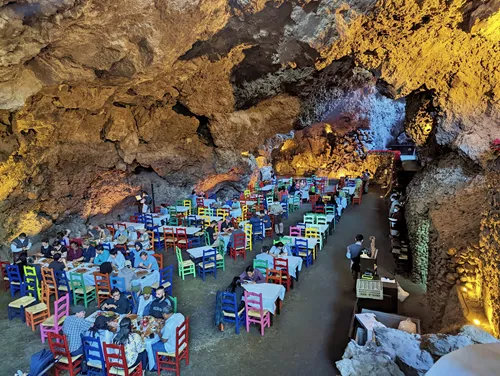

Basilica Lady of Guadalupe in Mexico City
If you can still walk, then our proposal is to visit Basilica Lady of Guadalupe (Insigne y Nacional Basílica de Santa María de Guadalupe).
You can either ask the bus driver to let you out near the basilica or take the bus back to the Autobuses del Norte station and from there take the metro to the La Villa / Basílica station on the red line (line 6).
Basilica of Santa María de Guadalupe is located on Tepeyac Hill and dedicated Our Lady of Guadalupe (the Blessed Virgin Mary and the patroness of Mexico). With approx. 20 million visitors, it is the second most visited Marian precinct in the world, only Saint Peter's Basilica in Vatican City has more visitors.
The history of Basilica Lady of Guadalupe in Mexico City
It is said that on December 9, 1531, the Virgin Mary tells a Mexican peasant named Juan Diego Cuauhtlatoatzin to convey a message to don Juan de Zumárraga, the bishop of Mexico, to build a chapel in her honor: Here I will hear their weeping, their sorrow and will remedy and alleviate all their multiple sufferings, necessities and misfortunes..
The bishop told Juan Diego to come back another day as he wanted to reflect on that.
When Juan Diego returned to his field in Tepeyac the same day, the Virgin appeared again and he told her what happened and suggests that maybe she should get someone with greater standing to be believed, but she insisted he go again.
Juan Diego went the next day (December 10), and the bishop asked for a sign that proves that the apparition was truly of heaven.
So, Juan Diego went back to his field and told the Virgin Mary what happened, and she said that he would provide a sign the next day (December 11).
Unfortunately, Juan’s uncle fell ill, and he had to attend to him all day on December 11.
Early on December 12, his uncle lay on his deathbed and Juan wanted to get a priest from another town. To avoid being delayed by the Virgin, Juan took another route and avoided his fields. The Virgin Mary, however, intercepted him and asked where he was going and why he did not show up on December 11. Juan told the story and the Virgin spoke her famous words: ¿No estoy yo aquí que soy tu madre? (Am I not here, I who am your mother?)
The Virgin assured Juan that his uncle had now recovered and told him to climb the hill and collect the flowers that were growing there. Juan Diego climbed the hill and was overwhelmed by the abundance of colorful flowers that grew where normally only cactus and scrubs grew. He used his mantle as a sack in which he collected the flowers and returned to the Virgin. She re-arranged the flowers and told him to take them to the bishop.
When Juan met the bishop later that day, Juan opened his mantle, the flowers poured to the floor, and the bishop saw they had left an imprint of the Virgin's image on the mantle. The bishop was impressed and kept the mantle.
The next day (December 13), Juan found that his uncle had fully recovered, and his uncle told him that he had seen the Virgin at his bed, too.
She had instructed him to tell the bishop of this apparition and miraculous cure.
On December 26, 1531, a procession was formed to take the mantle with the miraculous image back to Tepeyac, where it was installed in a small and quickly built chapel.
It took until 1695 that construction started on the temple that is today known as the Old Basilica of Guadalupe (Templo Expiatorio a Cristo Rey). The temple opened its doors in 1709.
In the early 19th century, the temple suffered serious damage and had to be partially rebuilt. That happened from 1804 to 1836.
In 1904, the temple was elevated to the rank of Basilica.
Over time, the Old Basilica unstable and dangerous and it was unable to accommodate the greater number of pilgrims. That’s why construction started in 1974 to the south of Tepeyac Hill on a new Basilica. After the work was finished in 1976, the Guadalupe image was taken to the New Basilica of Guadalupe in a procession.
The New Basilica of Guadalupe has seven entrances in the front and the interior is circular and self-supporting. The image of the Virgin of Guadalupe is located behind the altar under a large cross and can be seen from everywhere inside the basilica.
The New Basilica of Guadalupe has been visited by many high profile political and religious leaders, athletes, and artists. Pope John Paul II visited five times and in 2016, Pope Francis officiated a mass here.
The New Basilica of Guadalupe is open every day from 7am to 8pm, Sundays from 6am and admission is free.
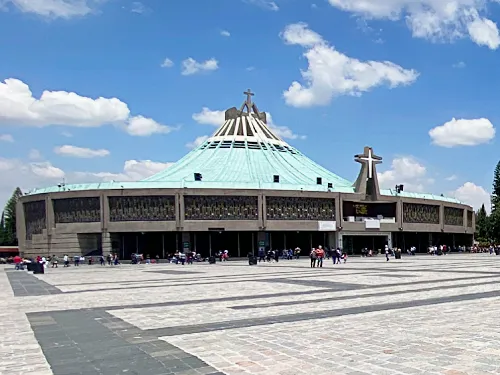
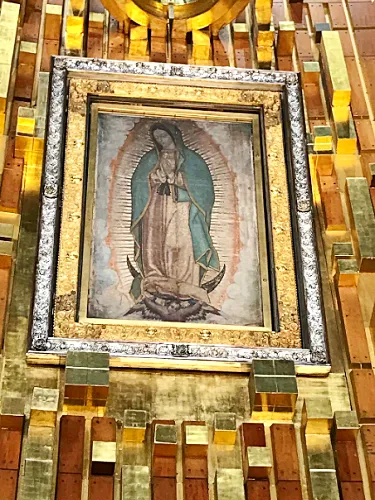
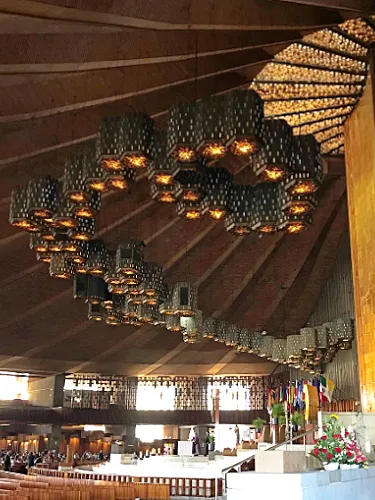

Self-guided walking tours of Mexico City
Author: Rudy at Backpack and Snorkel
Bio: Owner of Backpack and Snorkel Travel Guides. We create in-depth guides to help you plan unforgettable vacations around the world.
Other popular Purple Travel Guides you may be interested in:
Like this Backpack and Snorkel Purple Travel Guide? Pin these for later:


